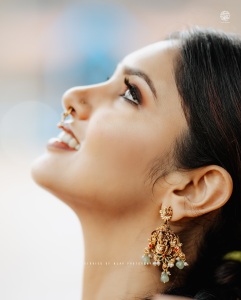
Saiyaara Review & Rating: A Heartfelt Musical Romance That Works as a One-Time Watch
ONE WORD: A Heartfelt Musical Romance That Works as a One-Time Watch.
A Review by Arunjyothi R
RELEASE DATE: July 18, 2025
LANGUAGE: Hindi
DURATION: 156 minutes
DIRECTOR: Mohit Suri
GENRE: Musical Romantic Drama
•POSITIVES:
1: Music and Background Score
2: Direction
3: Story
4: Performance of Ahaan Panday & Aneet Padda
5: Cinematography
6: Emotionally connecting
7: The song ‘Saiyaara’
8: Lyrics
9: Editing
•NEGATIVES:
1: Screenplay felt undercooked
2: At times the movie gets melodramatic
3: Templates of Aashiqui 2
STORY:
Saiyaara follows Krish Kapoor, a fiery musician chasing stardom, and Vaani Batra, a heartbroken poet still reeling from betrayal. Their bond forms over lost lyrics and shared dreams, with Vaani becoming his songwriter. Just as their love deepens and Krish’s career takes off, Vaani is diagnosed with early-onset Alzheimer’s — and the man who once shattered her returns, now holding power over their future. Then one day, Vaani disappears. For a year. What remains is a haunting love story built on music, memory, and everything in between.
REVIEW & ANALYSIS:
Saiyaara is a film that wears its heart on its sleeve — and the beating heart of it all is the music. With five soul-stirring tracks and an emotionally rich background score, the film draws you into its world of love, longing, and heartbreak. The songs are not just beautifully composed; they are carefully placed and intricately tied to the emotional rhythm of the narrative. From subtle piano notes to soaring orchestral swells, the music complements every phase of the story, adding layers to the characters’ emotional journeys. The lyrics deserve a special mention — each line feels pulled from the depths of a broken heart, with the title track ‘Saiyaara’ leaving a haunting imprint. It’s this musical foundation that carries much of the film’s emotional weight.
What elevates the impact further are the performances. Ahaan Panday makes a spectacular debut, portraying the tortured, passionate Krish with surprising maturity and depth. His expressions, dialogue delivery, and emotional breakdowns feel authentic, particularly in moments of heartbreak that hit hard and linger. Equally commendable is Aneet Padda, who brings quiet strength and vulnerability to her role as Vaani. Her chemistry with Ahaan feels natural and heartfelt, and she beautifully captures the silent suffering and emotional complexity of a woman holding onto fading memories and impossible love. Together, their performances form the emotional core of Saiyaara, making the love story feel personal and deeply relatable.
Visually, Saiyaara is a treat. The cinematography thoughtfully captures the emotional undertones with intimate close-ups and well-framed scenes that reflect the film’s romantic soul. The editing is clean and seamless, allowing the story to flow without distraction. Director Himanshu Singh offers a familiar template, reminiscent of films like Aashiqui 2, but adds freshness through music-driven storytelling and emotional detailing. His ability to align songs with the evolving phases of the relationship creates an immersive experience that speaks directly to those who’ve loved, lost, and still carry the hope of healing. The emotional scenes aren’t just dramatized — they evoke memories, stir past wounds, and connect deeply with broken hearts.
However, Saiyaara isn’t without its flaws. The screenplay is where the film stumbles. Despite a promising setup and emotional premise, the narrative lacks depth and unpredictability. Both halves occasionally veer into melodrama, and the story often plays it safe, relying on familiar tropes that reduce its impact. The influence of Aashiqui 2 is evident, sometimes too much so, with certain scenes and emotional beats mirroring the 2013 classic. While homage can be heartfelt, Saiyaara would have benefitted from a more original voice — one that could have helped it rise above comparisons and establish its own lasting identity. Still, for its music, performances, and emotional sincerity, Saiyaara leaves a mark — especially on hearts that still remember what it feels like to break.
SO WHAT’S HOT:
1: In Saiyaara, it’s the soul-stirring music and evocative background score that emerge as the film’s true driving force. While the story carries its share of emotional highs and lows, it’s the music that truly elevates the experience, weaving itself seamlessly into the narrative. As a romantic musical drama, Saiyaara leans heavily on its rich, heartfelt melodies — and rightfully so. Each song is laced with emotion, carrying the weight of unspoken feelings and unresolved moments. Together, the music and score form the emotional heartbeat of the film, keeping viewers engaged.
2: The background score in Saiyaara beautifully complements its music — both are emotionally charged and deeply immersive. From subtle piano strains to soaring orchestral swells, the score carries the weight of the film’s emotional arc. It not only maintains the narrative momentum but also intensifies the experience of love, loss, and longing. With every note, the background music makes you feel the heartbreak, the silence between words, and the raw ache of true love.
3: The film features five melodious tracks, each one a treat to the ears. What stands out is not just the music itself, but the thoughtful placement of every song — each composed and integrated with a clear understanding of the scene and emotion it accompanies. The songs don’t just play; they enhance the narrative, adding depth and resonance to every moment. Their execution feels organic, making every musical moment both impactful and emotionally meaningful.
4: Ahaan Panday makes a winning debut in Saiyaara, emerging as a true revelation. With remarkable depth and emotional precision, he breathes life into his character, portraying pain, love, and longing with a maturity far beyond his years. His screen presence is magnetic, anchoring the film even in its weaker moments. The heartbreak scenes, in particular, hit hard — leaving a lasting emotional impact. Backed by strong dialogue delivery and a natural ease in front of the camera, Ahaan delivers a performance that feels both powerful and genuine. For a first film, this is nothing short of brilliant — a star-making turn from a promising new talent.
5: Aneet Padda shines brilliantly in Saiyaara, delivering a performance that feels both genuine and emotionally resonant. Her ability to portray complex emotions with such natural ease is truly commendable. One of the film’s biggest strengths is the heartwarming chemistry she shares with Ahaan Panday — tender, romantic, and effortlessly believable. Aneet beautifully captures the silent struggles and emotional turmoil of her character, making the audience feel every bit of her pain and vulnerability. Her emotional range, especially in the heavier scenes, is remarkable, and her dialogue delivery is smooth, expressive, and completely in sync with the tone of the film. It’s a performance that deserves all the praise.
6: The placement of songs in Saiyaara is thoughtfully structured, showcasing the director’s clear understanding of emotional rhythm and narrative flow. Each track seamlessly connects with the scenes, amplifying the emotion and enhancing the storytelling. The direction maintains a steady pace throughout, never losing momentum. While the template of Saiyaara may feel familiar, it’s the director’s fresh approach that makes it stand out. His ability to blend music with the evolving phases of a relationship brings a unique emotional depth, making the film more immersive and engaging.
7: The lyrics in Saiyaara are one of the film’s most powerful assets — a true emotional triumph. Each word carries weight, resonating deeply with the heart and soul. The songs aren’t just beautifully written; they feel lived in, as if crafted straight from the pages of a broken heart. The way the lyrics blend with the scenes is almost magical — giving voice to unspoken pain, quiet hope, and the lingering ache of lost love. The title track ‘Saiyaara’ in particular is a hauntingly beautiful reminder of someone once loved beyond words — a song that wraps around your heart and doesn’t let go.
8: Creating a love story that truly connects with the audience — one that stirs memories of a broken past, cherished moments, and the faint hope of a reunion that may never happen — is no easy feat. It takes more than just storytelling; it requires emotional precision and deep sensitivity. In Saiyaara, that effort is clearly felt. The director, music composer, writers, and especially Ahaan Panday and the cast, come together with heartfelt sincerity. Their collective dedication breathes life into the film, making Saiyaara not just a story, but a lingering emotion — one that stays with you long after the screen fades to black.
9: The visual framing of Saiyaara beautifully mirrors the soul of the film. Every emotional moment is thoughtfully captured through well-composed shots and precise angles, especially the close-ups, which effectively convey the depth of the characters’ feelings. The film’s overall visual language is elegant and emotionally immersive. Editing, too, is seamless — with smooth transitions and no noticeable mismatches. While a few scenes occasionally drift into melodrama, the powerful performances and soul-stirring music effortlessly pull them back, grounding the narrative and keeping the emotions authentic and engaging.
SO WHAT DIDN’T WORK OUT:
1: If there’s one thread that slightly unravels Saiyaara’s emotional tapestry, it’s the screenplay. While the film has its heart in the right place and is backed by soulful music and heartfelt performances, the writing doesn’t always match up. Both the first and second halves occasionally drift into melodramatic territory, making some scenes feel a bit too familiar or overplayed. There’s a noticeable lack of surprise, with certain plot turns feeling predictable and safe. With a more layered and emotionally grounded script, Saiyaara could have soared higher. Instead, it plays it too straight, missing moments where it could’ve truly stirred or shaken its audience.
2: Another aspect where Saiyaara stumbles is its screenplay. While the film carries emotional weight, both halves often flirt with the edge of melodrama, occasionally tipping into it. The narrative feels predictable at times, making the viewing experience less gripping than it could have been. A more tightly written screenplay — with sharper turns and deeper layering — could’ve elevated the film and kept the emotional flow from becoming too familiar. Despite its heartfelt moments, the script misses the chance to truly surprise or challenge the audience.
3: Saiyaara carries a noticeable influence from Aashiqui 2, both in its narrative structure and emotional tone. The template and storytelling pattern closely mirror the 2013 classic, and at times, the similarities become a bit too evident. Certain scenes featuring Ahaan Panday strongly resemble moments from Aditya Roy Kapur’s performance in Aashiqui 2 — from emotional breakdowns to his physical mannerisms — but they don’t always blend naturally into Saiyaara’s context. While inspiration is understandable in romantic musicals, relying too heavily on familiar tropes made some parts feel repetitive rather than refreshing. A more original approach could have helped Saiyaara carve out a stronger identity of its own.
PERFORMANCE OF ACTORS:
Ahaan Panday makes a remarkably confident debut in Saiyaara, delivering a performance that is both emotionally charged and deeply engaging. He portrays Krish with surprising maturity, capturing the pain, passion, and vulnerability of a struggling artist torn between ambition and love. His expressions feel genuine, particularly in scenes of heartbreak, where his emotional breakdowns strike a powerful chord. Ahaan’s strong screen presence and measured dialogue delivery reflect a natural flair for acting. In a film that occasionally leans into melodrama, it’s his grounded performance that keeps the emotional arc sincere and relatable — a debut that truly marks him as a talent to watch.
Aneet Padda brings quiet strength and heartfelt sensitivity to her role as Vaani. She plays the character with remarkable grace, portraying the layers of forgotten memories, emotional trauma, and fragile hope with a natural ease. Her chemistry with Ahaan Panday feels effortless and warm, making their bond all the more believable. What stands out in Aneet’s performance is her ability to convey pain in silence — her eyes often saying more than the words. In the emotionally heavy scenes, she holds her ground with poise, ensuring that the audience not only sees her character’s struggles but feels them. It’s a performance filled with depth, subtlety, and emotional honesty.
MUSIC AND BACKGROUND SCORE:
The music of Saiyaara stands as the film’s emotional core, with all five tracks weaving seamlessly into the narrative and leaving a heartfelt impact. The title song “Saiyaara” is a soul-touching melody that beautifully expresses the pain of lost love, serving as the emotional anchor of the film. “Tere Bin Rehna Paaye” brings a soft, romantic charm, underlining the tender connection between the lead characters. “Yaadon Ke Mausam” strikes a nostalgic chord with its poetic verses and gentle composition, elegantly linking memories to the present. “Tu Hi Toh Hai” adds a warm glow of hope, portraying love as a calming presence amidst emotional storms. Meanwhile, “Khamoshiyaan Bhi Keh Gayi” delivers a quiet yet powerful emotional punch, capturing the sorrow and silence of love slipping away. These aren’t just songs — they’re emotional extensions of the story, making Saiyaara a musically enriched cinematic experience.
CONCLUSION:
In the end, Saiyaara stands as a new-age romantic drama that leans heavily on emotion, music, and heartfelt performances to tell its story. While its screenplay follows a familiar path and occasionally slips into melodrama, the film is redeemed by its soul-stirring soundtrack, touching moments, and the sincere efforts of its lead cast. Ahaan Panday’s impressive debut and Aneet Padda’s emotionally grounded portrayal bring depth to this tale of love, loss, and longing. With its rich musical backdrop and emotionally resonant core, Saiyaara may not break new ground, but it beautifully captures the essence of love in its most vulnerable form — making it a worthwhile journey for the romantics at heart.
VERDICT: A Melodious Romantic Tale That’s Worth a Watch
RATING: 3/5
A Review by Arunjyothi. R

































































































